Down Syndrome Care: Meeting Needs with APIE Model & Reflection
VerifiedAdded on 2023/06/18
|10
|3793
|221
Report
AI Summary
This report focuses on developing a care plan for Ola, a 30-year-old individual with Down syndrome, using the APIE (Assessment, Planning, Implementation, and Evaluation) model. The assessment phase identifies Ola's strengths, weaknesses, and care needs, highlighting the importance of both quantitative and qualitative data. Planning involves person-centered care, considering individual and social models of disability, with goals focusing on improving speech, motor skills, and independence. Interventions include speech therapy, physical therapy, and assistive technology, all aimed at enhancing Ola's quality of life and social integration. The report emphasizes the role of social care workers in coordinating these therapies and providing ongoing support. The ultimate aim is to empower Ola to achieve greater independence and participate more fully in social and community life.
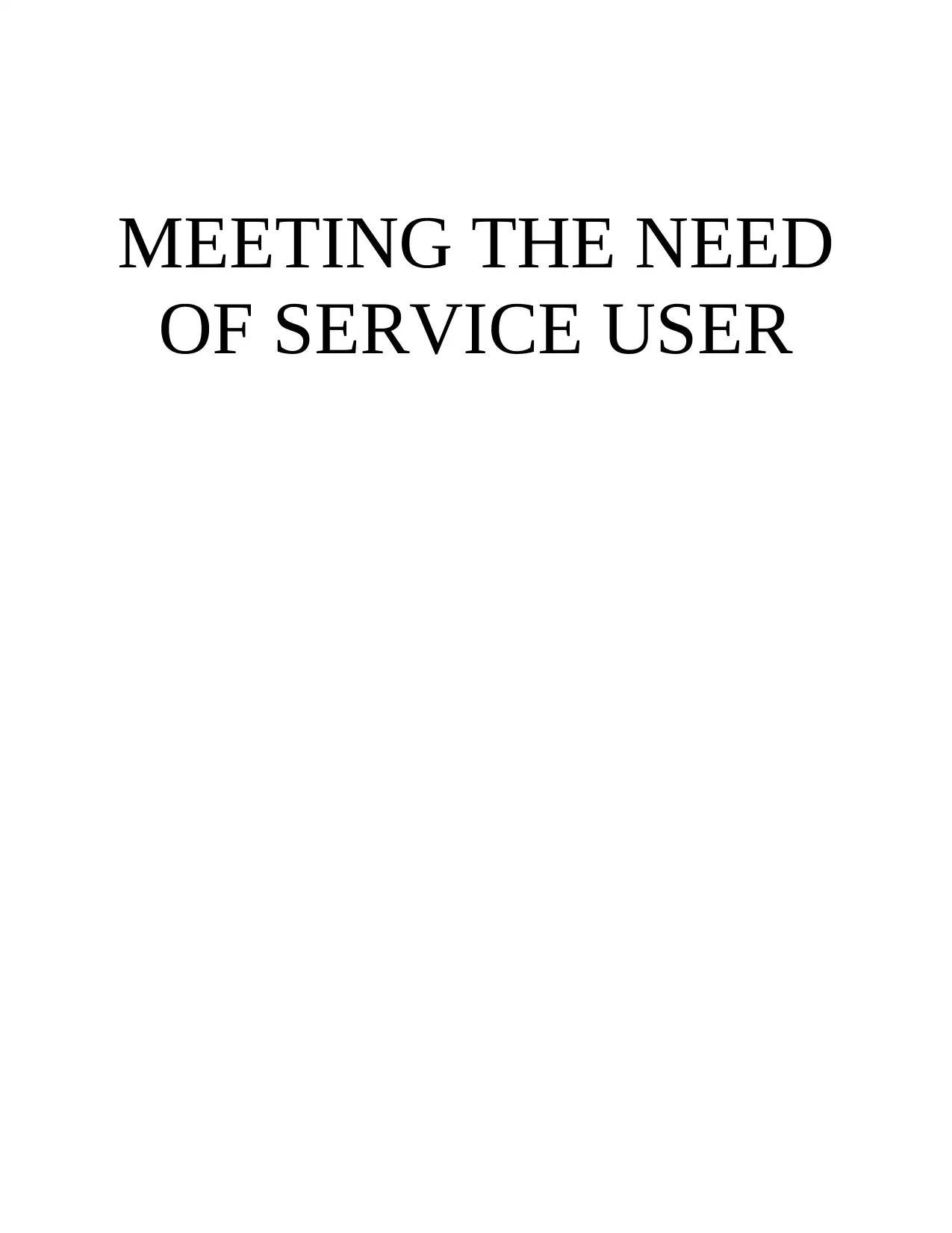
MEETING THE NEED
OF SERVICE USER
OF SERVICE USER
Paraphrase This Document
Need a fresh take? Get an instant paraphrase of this document with our AI Paraphraser
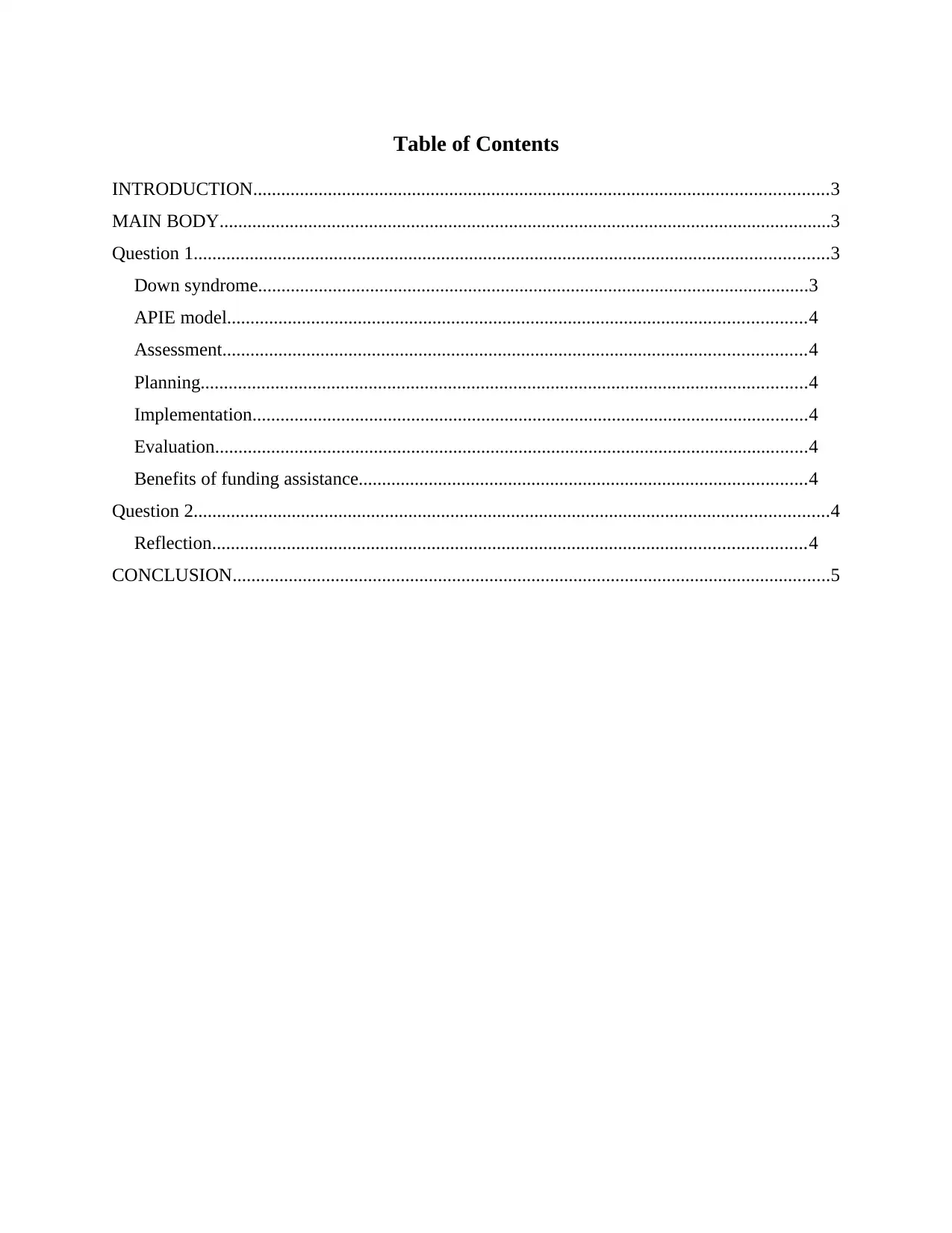
Table of Contents
INTRODUCTION...........................................................................................................................3
MAIN BODY...................................................................................................................................3
Question 1........................................................................................................................................3
Down syndrome......................................................................................................................3
APIE model............................................................................................................................4
Assessment.............................................................................................................................4
Planning..................................................................................................................................4
Implementation.......................................................................................................................4
Evaluation...............................................................................................................................4
Benefits of funding assistance................................................................................................4
Question 2........................................................................................................................................4
Reflection...............................................................................................................................4
CONCLUSION................................................................................................................................5
INTRODUCTION...........................................................................................................................3
MAIN BODY...................................................................................................................................3
Question 1........................................................................................................................................3
Down syndrome......................................................................................................................3
APIE model............................................................................................................................4
Assessment.............................................................................................................................4
Planning..................................................................................................................................4
Implementation.......................................................................................................................4
Evaluation...............................................................................................................................4
Benefits of funding assistance................................................................................................4
Question 2........................................................................................................................................4
Reflection...............................................................................................................................4
CONCLUSION................................................................................................................................5
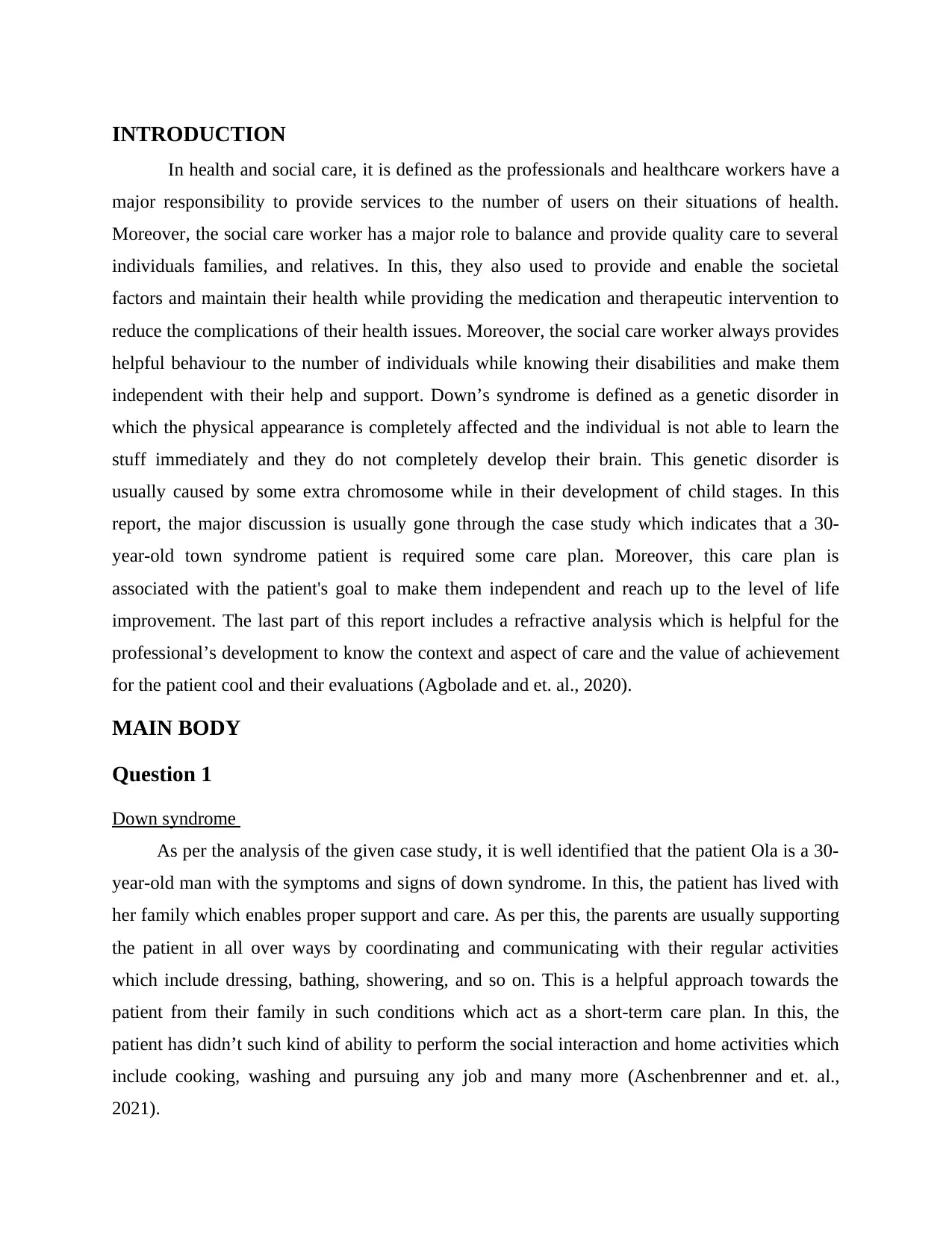
INTRODUCTION
In health and social care, it is defined as the professionals and healthcare workers have a
major responsibility to provide services to the number of users on their situations of health.
Moreover, the social care worker has a major role to balance and provide quality care to several
individuals families, and relatives. In this, they also used to provide and enable the societal
factors and maintain their health while providing the medication and therapeutic intervention to
reduce the complications of their health issues. Moreover, the social care worker always provides
helpful behaviour to the number of individuals while knowing their disabilities and make them
independent with their help and support. Down’s syndrome is defined as a genetic disorder in
which the physical appearance is completely affected and the individual is not able to learn the
stuff immediately and they do not completely develop their brain. This genetic disorder is
usually caused by some extra chromosome while in their development of child stages. In this
report, the major discussion is usually gone through the case study which indicates that a 30-
year-old town syndrome patient is required some care plan. Moreover, this care plan is
associated with the patient's goal to make them independent and reach up to the level of life
improvement. The last part of this report includes a refractive analysis which is helpful for the
professional’s development to know the context and aspect of care and the value of achievement
for the patient cool and their evaluations (Agbolade and et. al., 2020).
MAIN BODY
Question 1
Down syndrome
As per the analysis of the given case study, it is well identified that the patient Ola is a 30-
year-old man with the symptoms and signs of down syndrome. In this, the patient has lived with
her family which enables proper support and care. As per this, the parents are usually supporting
the patient in all over ways by coordinating and communicating with their regular activities
which include dressing, bathing, showering, and so on. This is a helpful approach towards the
patient from their family in such conditions which act as a short-term care plan. In this, the
patient has didn’t such kind of ability to perform the social interaction and home activities which
include cooking, washing and pursuing any job and many more (Aschenbrenner and et. al.,
2021).
In health and social care, it is defined as the professionals and healthcare workers have a
major responsibility to provide services to the number of users on their situations of health.
Moreover, the social care worker has a major role to balance and provide quality care to several
individuals families, and relatives. In this, they also used to provide and enable the societal
factors and maintain their health while providing the medication and therapeutic intervention to
reduce the complications of their health issues. Moreover, the social care worker always provides
helpful behaviour to the number of individuals while knowing their disabilities and make them
independent with their help and support. Down’s syndrome is defined as a genetic disorder in
which the physical appearance is completely affected and the individual is not able to learn the
stuff immediately and they do not completely develop their brain. This genetic disorder is
usually caused by some extra chromosome while in their development of child stages. In this
report, the major discussion is usually gone through the case study which indicates that a 30-
year-old town syndrome patient is required some care plan. Moreover, this care plan is
associated with the patient's goal to make them independent and reach up to the level of life
improvement. The last part of this report includes a refractive analysis which is helpful for the
professional’s development to know the context and aspect of care and the value of achievement
for the patient cool and their evaluations (Agbolade and et. al., 2020).
MAIN BODY
Question 1
Down syndrome
As per the analysis of the given case study, it is well identified that the patient Ola is a 30-
year-old man with the symptoms and signs of down syndrome. In this, the patient has lived with
her family which enables proper support and care. As per this, the parents are usually supporting
the patient in all over ways by coordinating and communicating with their regular activities
which include dressing, bathing, showering, and so on. This is a helpful approach towards the
patient from their family in such conditions which act as a short-term care plan. In this, the
patient has didn’t such kind of ability to perform the social interaction and home activities which
include cooking, washing and pursuing any job and many more (Aschenbrenner and et. al.,
2021).
⊘ This is a preview!⊘
Do you want full access?
Subscribe today to unlock all pages.

Trusted by 1+ million students worldwide
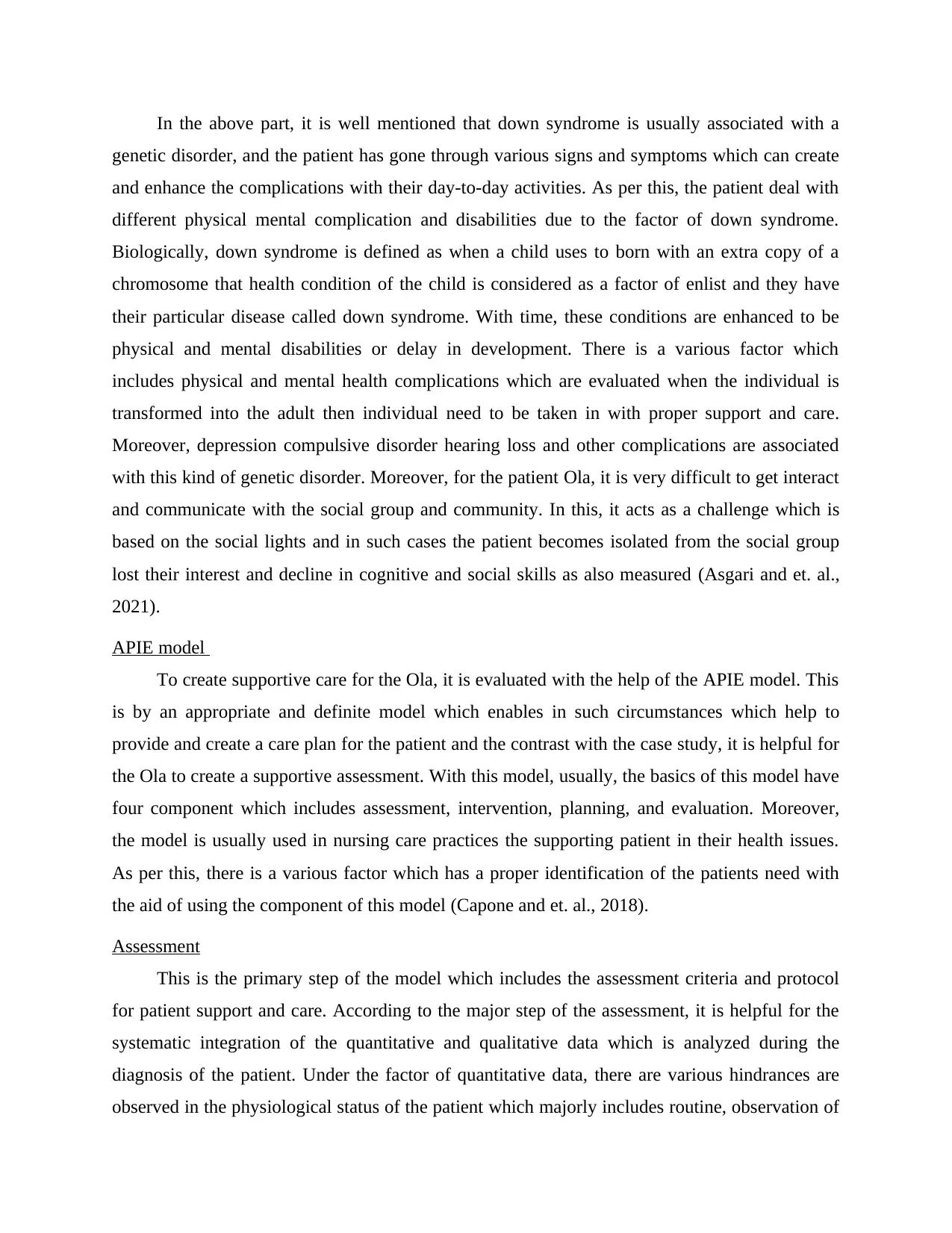
In the above part, it is well mentioned that down syndrome is usually associated with a
genetic disorder, and the patient has gone through various signs and symptoms which can create
and enhance the complications with their day-to-day activities. As per this, the patient deal with
different physical mental complication and disabilities due to the factor of down syndrome.
Biologically, down syndrome is defined as when a child uses to born with an extra copy of a
chromosome that health condition of the child is considered as a factor of enlist and they have
their particular disease called down syndrome. With time, these conditions are enhanced to be
physical and mental disabilities or delay in development. There is a various factor which
includes physical and mental health complications which are evaluated when the individual is
transformed into the adult then individual need to be taken in with proper support and care.
Moreover, depression compulsive disorder hearing loss and other complications are associated
with this kind of genetic disorder. Moreover, for the patient Ola, it is very difficult to get interact
and communicate with the social group and community. In this, it acts as a challenge which is
based on the social lights and in such cases the patient becomes isolated from the social group
lost their interest and decline in cognitive and social skills as also measured (Asgari and et. al.,
2021).
APIE model
To create supportive care for the Ola, it is evaluated with the help of the APIE model. This
is by an appropriate and definite model which enables in such circumstances which help to
provide and create a care plan for the patient and the contrast with the case study, it is helpful for
the Ola to create a supportive assessment. With this model, usually, the basics of this model have
four component which includes assessment, intervention, planning, and evaluation. Moreover,
the model is usually used in nursing care practices the supporting patient in their health issues.
As per this, there is a various factor which has a proper identification of the patients need with
the aid of using the component of this model (Capone and et. al., 2018).
Assessment
This is the primary step of the model which includes the assessment criteria and protocol
for patient support and care. According to the major step of the assessment, it is helpful for the
systematic integration of the quantitative and qualitative data which is analyzed during the
diagnosis of the patient. Under the factor of quantitative data, there are various hindrances are
observed in the physiological status of the patient which majorly includes routine, observation of
genetic disorder, and the patient has gone through various signs and symptoms which can create
and enhance the complications with their day-to-day activities. As per this, the patient deal with
different physical mental complication and disabilities due to the factor of down syndrome.
Biologically, down syndrome is defined as when a child uses to born with an extra copy of a
chromosome that health condition of the child is considered as a factor of enlist and they have
their particular disease called down syndrome. With time, these conditions are enhanced to be
physical and mental disabilities or delay in development. There is a various factor which
includes physical and mental health complications which are evaluated when the individual is
transformed into the adult then individual need to be taken in with proper support and care.
Moreover, depression compulsive disorder hearing loss and other complications are associated
with this kind of genetic disorder. Moreover, for the patient Ola, it is very difficult to get interact
and communicate with the social group and community. In this, it acts as a challenge which is
based on the social lights and in such cases the patient becomes isolated from the social group
lost their interest and decline in cognitive and social skills as also measured (Asgari and et. al.,
2021).
APIE model
To create supportive care for the Ola, it is evaluated with the help of the APIE model. This
is by an appropriate and definite model which enables in such circumstances which help to
provide and create a care plan for the patient and the contrast with the case study, it is helpful for
the Ola to create a supportive assessment. With this model, usually, the basics of this model have
four component which includes assessment, intervention, planning, and evaluation. Moreover,
the model is usually used in nursing care practices the supporting patient in their health issues.
As per this, there is a various factor which has a proper identification of the patients need with
the aid of using the component of this model (Capone and et. al., 2018).
Assessment
This is the primary step of the model which includes the assessment criteria and protocol
for patient support and care. According to the major step of the assessment, it is helpful for the
systematic integration of the quantitative and qualitative data which is analyzed during the
diagnosis of the patient. Under the factor of quantitative data, there are various hindrances are
observed in the physiological status of the patient which majorly includes routine, observation of
Paraphrase This Document
Need a fresh take? Get an instant paraphrase of this document with our AI Paraphraser
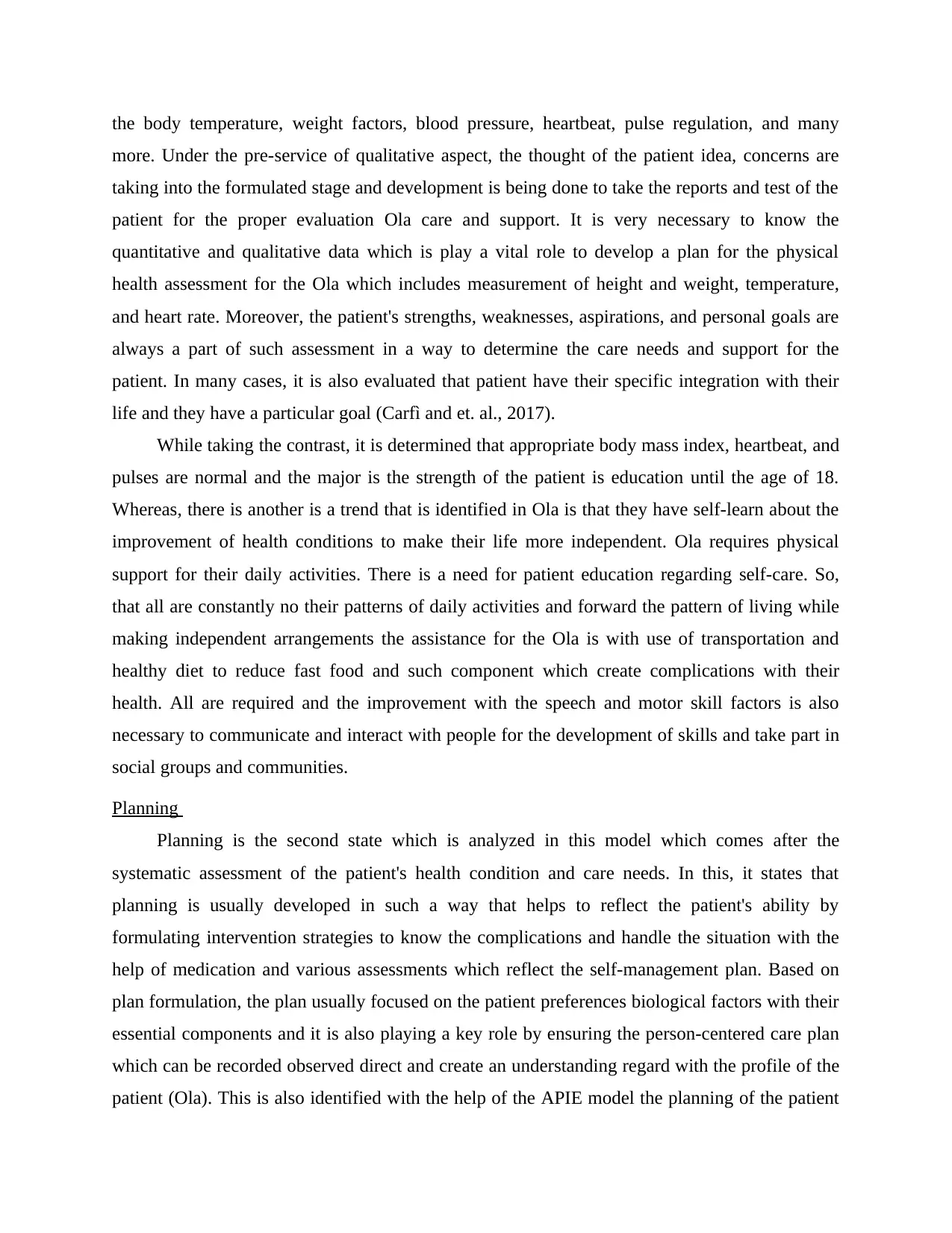
the body temperature, weight factors, blood pressure, heartbeat, pulse regulation, and many
more. Under the pre-service of qualitative aspect, the thought of the patient idea, concerns are
taking into the formulated stage and development is being done to take the reports and test of the
patient for the proper evaluation Ola care and support. It is very necessary to know the
quantitative and qualitative data which is play a vital role to develop a plan for the physical
health assessment for the Ola which includes measurement of height and weight, temperature,
and heart rate. Moreover, the patient's strengths, weaknesses, aspirations, and personal goals are
always a part of such assessment in a way to determine the care needs and support for the
patient. In many cases, it is also evaluated that patient have their specific integration with their
life and they have a particular goal (Carfì and et. al., 2017).
While taking the contrast, it is determined that appropriate body mass index, heartbeat, and
pulses are normal and the major is the strength of the patient is education until the age of 18.
Whereas, there is another is a trend that is identified in Ola is that they have self-learn about the
improvement of health conditions to make their life more independent. Ola requires physical
support for their daily activities. There is a need for patient education regarding self-care. So,
that all are constantly no their patterns of daily activities and forward the pattern of living while
making independent arrangements the assistance for the Ola is with use of transportation and
healthy diet to reduce fast food and such component which create complications with their
health. All are required and the improvement with the speech and motor skill factors is also
necessary to communicate and interact with people for the development of skills and take part in
social groups and communities.
Planning
Planning is the second state which is analyzed in this model which comes after the
systematic assessment of the patient's health condition and care needs. In this, it states that
planning is usually developed in such a way that helps to reflect the patient's ability by
formulating intervention strategies to know the complications and handle the situation with the
help of medication and various assessments which reflect the self-management plan. Based on
plan formulation, the plan usually focused on the patient preferences biological factors with their
essential components and it is also playing a key role by ensuring the person-centered care plan
which can be recorded observed direct and create an understanding regard with the profile of the
patient (Ola). This is also identified with the help of the APIE model the planning of the patient
more. Under the pre-service of qualitative aspect, the thought of the patient idea, concerns are
taking into the formulated stage and development is being done to take the reports and test of the
patient for the proper evaluation Ola care and support. It is very necessary to know the
quantitative and qualitative data which is play a vital role to develop a plan for the physical
health assessment for the Ola which includes measurement of height and weight, temperature,
and heart rate. Moreover, the patient's strengths, weaknesses, aspirations, and personal goals are
always a part of such assessment in a way to determine the care needs and support for the
patient. In many cases, it is also evaluated that patient have their specific integration with their
life and they have a particular goal (Carfì and et. al., 2017).
While taking the contrast, it is determined that appropriate body mass index, heartbeat, and
pulses are normal and the major is the strength of the patient is education until the age of 18.
Whereas, there is another is a trend that is identified in Ola is that they have self-learn about the
improvement of health conditions to make their life more independent. Ola requires physical
support for their daily activities. There is a need for patient education regarding self-care. So,
that all are constantly no their patterns of daily activities and forward the pattern of living while
making independent arrangements the assistance for the Ola is with use of transportation and
healthy diet to reduce fast food and such component which create complications with their
health. All are required and the improvement with the speech and motor skill factors is also
necessary to communicate and interact with people for the development of skills and take part in
social groups and communities.
Planning
Planning is the second state which is analyzed in this model which comes after the
systematic assessment of the patient's health condition and care needs. In this, it states that
planning is usually developed in such a way that helps to reflect the patient's ability by
formulating intervention strategies to know the complications and handle the situation with the
help of medication and various assessments which reflect the self-management plan. Based on
plan formulation, the plan usually focused on the patient preferences biological factors with their
essential components and it is also playing a key role by ensuring the person-centered care plan
which can be recorded observed direct and create an understanding regard with the profile of the
patient (Ola). This is also identified with the help of the APIE model the planning of the patient
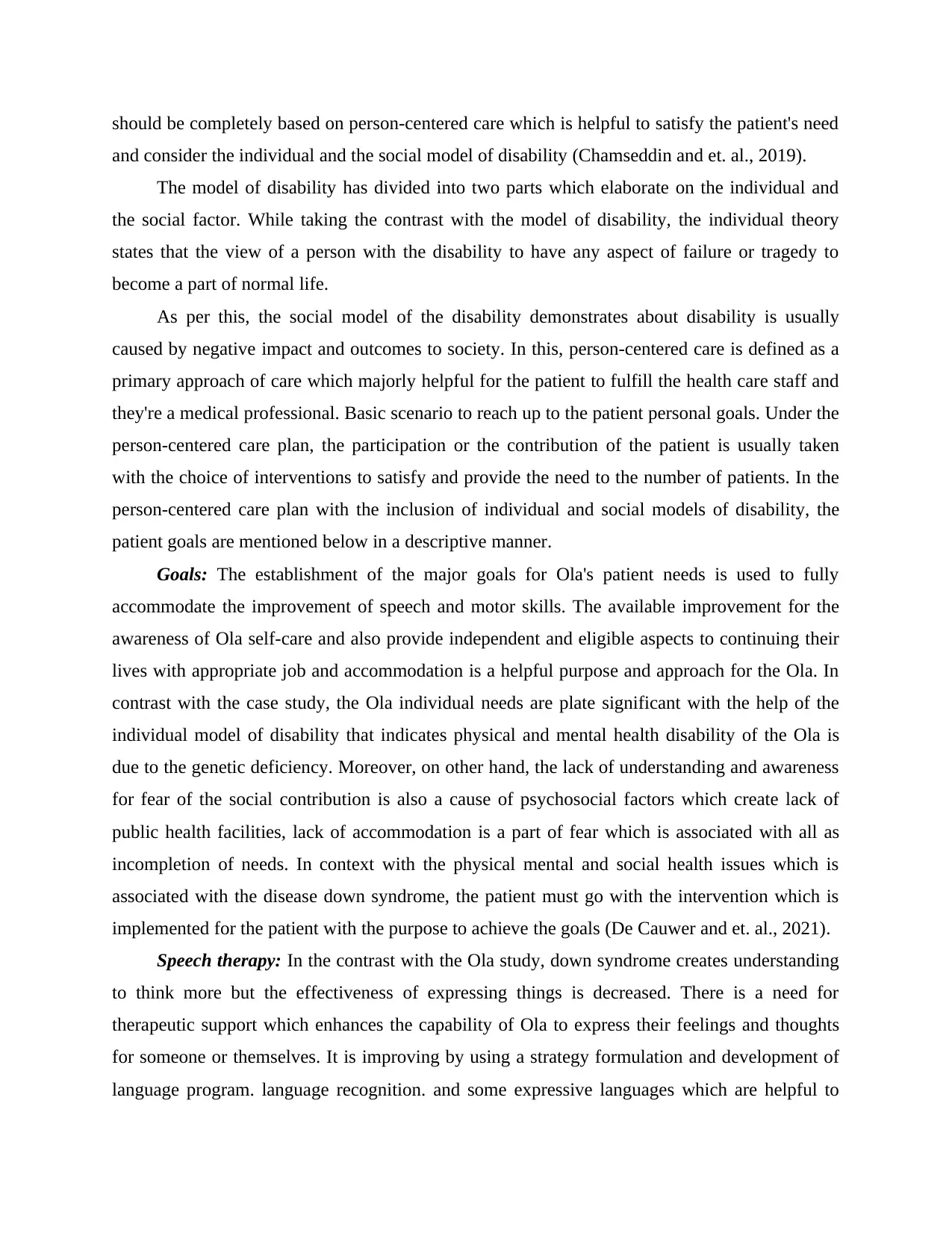
should be completely based on person-centered care which is helpful to satisfy the patient's need
and consider the individual and the social model of disability (Chamseddin and et. al., 2019).
The model of disability has divided into two parts which elaborate on the individual and
the social factor. While taking the contrast with the model of disability, the individual theory
states that the view of a person with the disability to have any aspect of failure or tragedy to
become a part of normal life.
As per this, the social model of the disability demonstrates about disability is usually
caused by negative impact and outcomes to society. In this, person-centered care is defined as a
primary approach of care which majorly helpful for the patient to fulfill the health care staff and
they're a medical professional. Basic scenario to reach up to the patient personal goals. Under the
person-centered care plan, the participation or the contribution of the patient is usually taken
with the choice of interventions to satisfy and provide the need to the number of patients. In the
person-centered care plan with the inclusion of individual and social models of disability, the
patient goals are mentioned below in a descriptive manner.
Goals: The establishment of the major goals for Ola's patient needs is used to fully
accommodate the improvement of speech and motor skills. The available improvement for the
awareness of Ola self-care and also provide independent and eligible aspects to continuing their
lives with appropriate job and accommodation is a helpful purpose and approach for the Ola. In
contrast with the case study, the Ola individual needs are plate significant with the help of the
individual model of disability that indicates physical and mental health disability of the Ola is
due to the genetic deficiency. Moreover, on other hand, the lack of understanding and awareness
for fear of the social contribution is also a cause of psychosocial factors which create lack of
public health facilities, lack of accommodation is a part of fear which is associated with all as
incompletion of needs. In context with the physical mental and social health issues which is
associated with the disease down syndrome, the patient must go with the intervention which is
implemented for the patient with the purpose to achieve the goals (De Cauwer and et. al., 2021).
Speech therapy: In the contrast with the Ola study, down syndrome creates understanding
to think more but the effectiveness of expressing things is decreased. There is a need for
therapeutic support which enhances the capability of Ola to express their feelings and thoughts
for someone or themselves. It is improving by using a strategy formulation and development of
language program. language recognition. and some expressive languages which are helpful to
and consider the individual and the social model of disability (Chamseddin and et. al., 2019).
The model of disability has divided into two parts which elaborate on the individual and
the social factor. While taking the contrast with the model of disability, the individual theory
states that the view of a person with the disability to have any aspect of failure or tragedy to
become a part of normal life.
As per this, the social model of the disability demonstrates about disability is usually
caused by negative impact and outcomes to society. In this, person-centered care is defined as a
primary approach of care which majorly helpful for the patient to fulfill the health care staff and
they're a medical professional. Basic scenario to reach up to the patient personal goals. Under the
person-centered care plan, the participation or the contribution of the patient is usually taken
with the choice of interventions to satisfy and provide the need to the number of patients. In the
person-centered care plan with the inclusion of individual and social models of disability, the
patient goals are mentioned below in a descriptive manner.
Goals: The establishment of the major goals for Ola's patient needs is used to fully
accommodate the improvement of speech and motor skills. The available improvement for the
awareness of Ola self-care and also provide independent and eligible aspects to continuing their
lives with appropriate job and accommodation is a helpful purpose and approach for the Ola. In
contrast with the case study, the Ola individual needs are plate significant with the help of the
individual model of disability that indicates physical and mental health disability of the Ola is
due to the genetic deficiency. Moreover, on other hand, the lack of understanding and awareness
for fear of the social contribution is also a cause of psychosocial factors which create lack of
public health facilities, lack of accommodation is a part of fear which is associated with all as
incompletion of needs. In context with the physical mental and social health issues which is
associated with the disease down syndrome, the patient must go with the intervention which is
implemented for the patient with the purpose to achieve the goals (De Cauwer and et. al., 2021).
Speech therapy: In the contrast with the Ola study, down syndrome creates understanding
to think more but the effectiveness of expressing things is decreased. There is a need for
therapeutic support which enhances the capability of Ola to express their feelings and thoughts
for someone or themselves. It is improving by using a strategy formulation and development of
language program. language recognition. and some expressive languages which are helpful to
⊘ This is a preview!⊘
Do you want full access?
Subscribe today to unlock all pages.

Trusted by 1+ million students worldwide
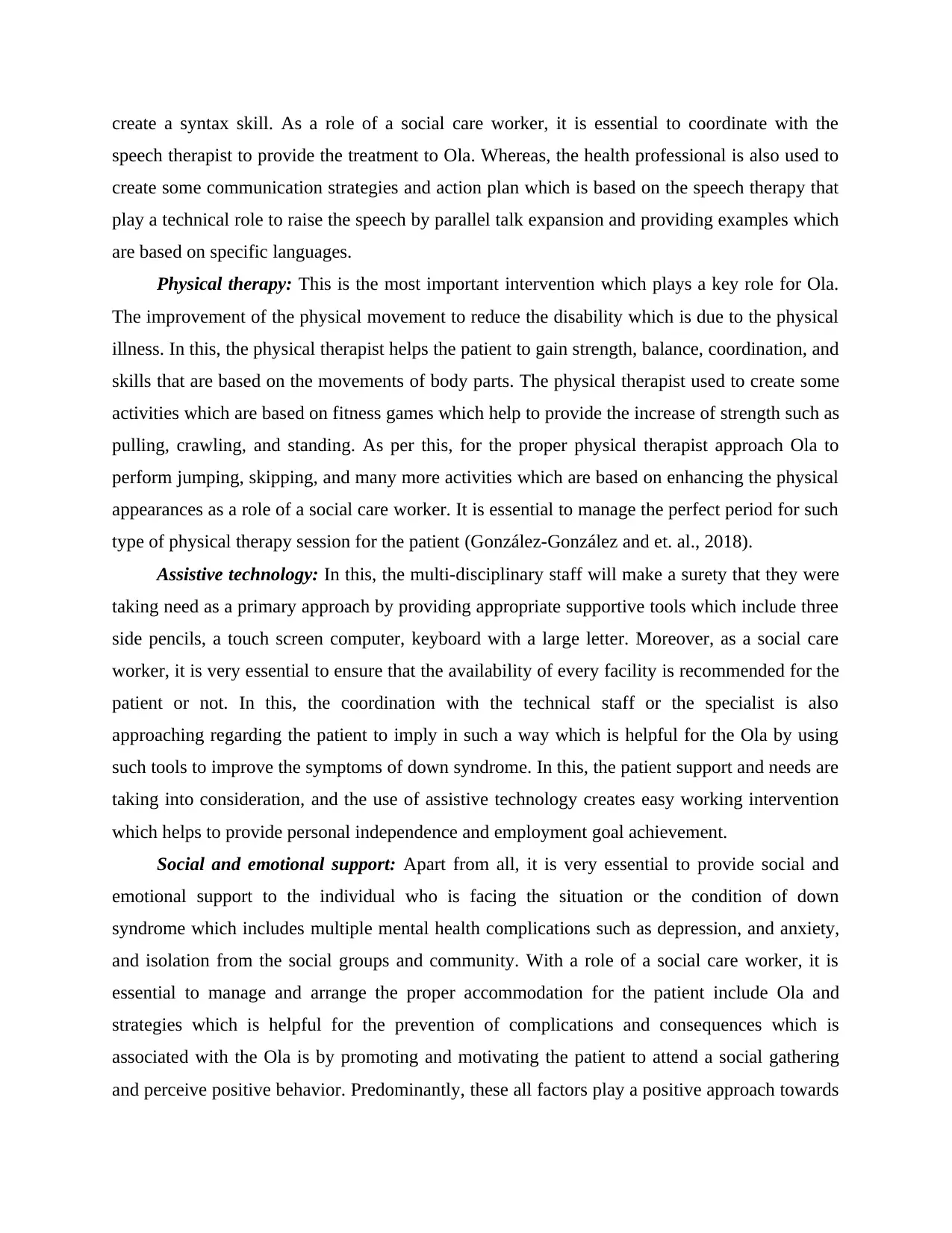
create a syntax skill. As a role of a social care worker, it is essential to coordinate with the
speech therapist to provide the treatment to Ola. Whereas, the health professional is also used to
create some communication strategies and action plan which is based on the speech therapy that
play a technical role to raise the speech by parallel talk expansion and providing examples which
are based on specific languages.
Physical therapy: This is the most important intervention which plays a key role for Ola.
The improvement of the physical movement to reduce the disability which is due to the physical
illness. In this, the physical therapist helps the patient to gain strength, balance, coordination, and
skills that are based on the movements of body parts. The physical therapist used to create some
activities which are based on fitness games which help to provide the increase of strength such as
pulling, crawling, and standing. As per this, for the proper physical therapist approach Ola to
perform jumping, skipping, and many more activities which are based on enhancing the physical
appearances as a role of a social care worker. It is essential to manage the perfect period for such
type of physical therapy session for the patient (González-González and et. al., 2018).
Assistive technology: In this, the multi-disciplinary staff will make a surety that they were
taking need as a primary approach by providing appropriate supportive tools which include three
side pencils, a touch screen computer, keyboard with a large letter. Moreover, as a social care
worker, it is very essential to ensure that the availability of every facility is recommended for the
patient or not. In this, the coordination with the technical staff or the specialist is also
approaching regarding the patient to imply in such a way which is helpful for the Ola by using
such tools to improve the symptoms of down syndrome. In this, the patient support and needs are
taking into consideration, and the use of assistive technology creates easy working intervention
which helps to provide personal independence and employment goal achievement.
Social and emotional support: Apart from all, it is very essential to provide social and
emotional support to the individual who is facing the situation or the condition of down
syndrome which includes multiple mental health complications such as depression, and anxiety,
and isolation from the social groups and community. With a role of a social care worker, it is
essential to manage and arrange the proper accommodation for the patient include Ola and
strategies which is helpful for the prevention of complications and consequences which is
associated with the Ola is by promoting and motivating the patient to attend a social gathering
and perceive positive behavior. Predominantly, these all factors play a positive approach towards
speech therapist to provide the treatment to Ola. Whereas, the health professional is also used to
create some communication strategies and action plan which is based on the speech therapy that
play a technical role to raise the speech by parallel talk expansion and providing examples which
are based on specific languages.
Physical therapy: This is the most important intervention which plays a key role for Ola.
The improvement of the physical movement to reduce the disability which is due to the physical
illness. In this, the physical therapist helps the patient to gain strength, balance, coordination, and
skills that are based on the movements of body parts. The physical therapist used to create some
activities which are based on fitness games which help to provide the increase of strength such as
pulling, crawling, and standing. As per this, for the proper physical therapist approach Ola to
perform jumping, skipping, and many more activities which are based on enhancing the physical
appearances as a role of a social care worker. It is essential to manage the perfect period for such
type of physical therapy session for the patient (González-González and et. al., 2018).
Assistive technology: In this, the multi-disciplinary staff will make a surety that they were
taking need as a primary approach by providing appropriate supportive tools which include three
side pencils, a touch screen computer, keyboard with a large letter. Moreover, as a social care
worker, it is very essential to ensure that the availability of every facility is recommended for the
patient or not. In this, the coordination with the technical staff or the specialist is also
approaching regarding the patient to imply in such a way which is helpful for the Ola by using
such tools to improve the symptoms of down syndrome. In this, the patient support and needs are
taking into consideration, and the use of assistive technology creates easy working intervention
which helps to provide personal independence and employment goal achievement.
Social and emotional support: Apart from all, it is very essential to provide social and
emotional support to the individual who is facing the situation or the condition of down
syndrome which includes multiple mental health complications such as depression, and anxiety,
and isolation from the social groups and community. With a role of a social care worker, it is
essential to manage and arrange the proper accommodation for the patient include Ola and
strategies which is helpful for the prevention of complications and consequences which is
associated with the Ola is by promoting and motivating the patient to attend a social gathering
and perceive positive behavior. Predominantly, these all factors play a positive approach towards
Paraphrase This Document
Need a fresh take? Get an instant paraphrase of this document with our AI Paraphraser
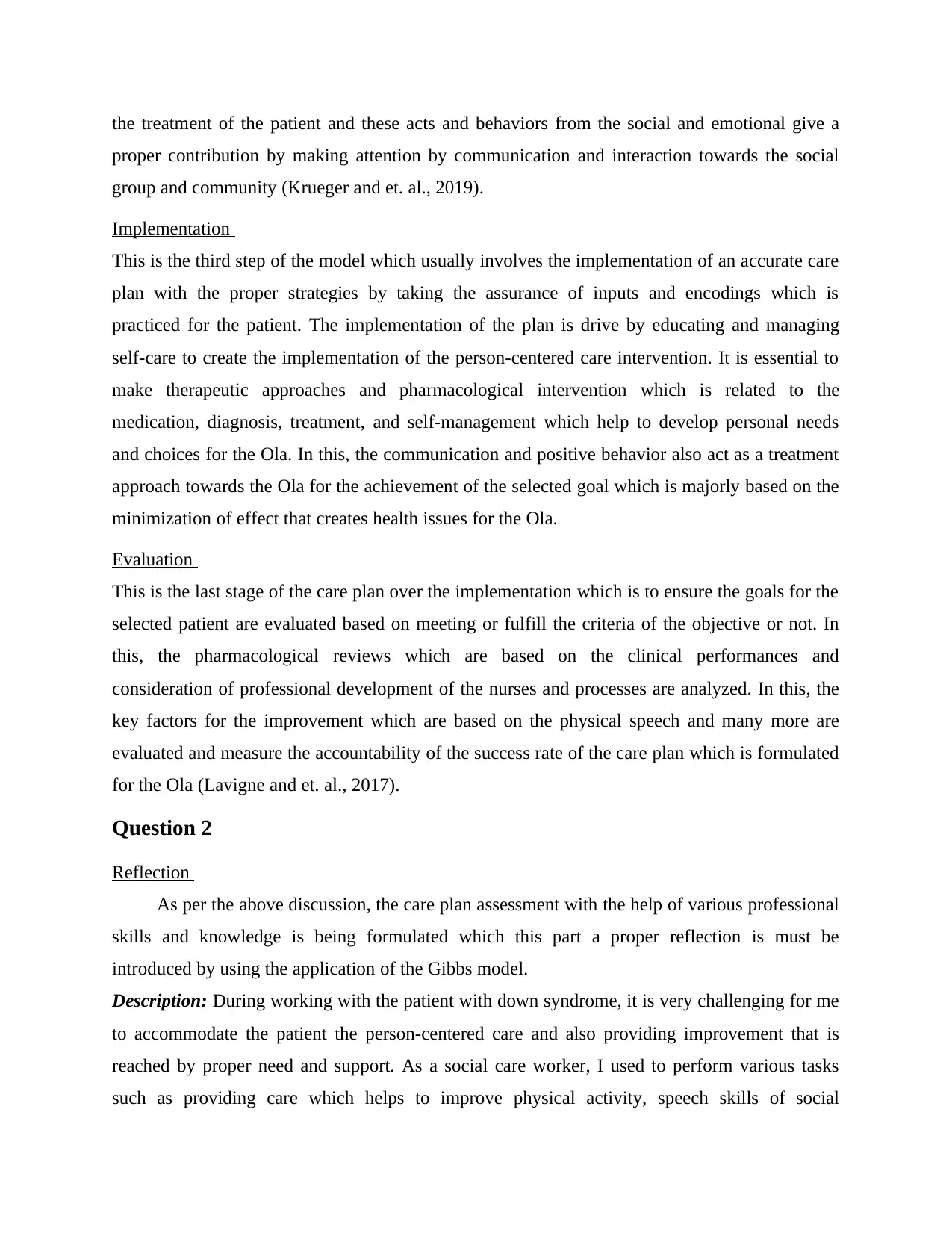
the treatment of the patient and these acts and behaviors from the social and emotional give a
proper contribution by making attention by communication and interaction towards the social
group and community (Krueger and et. al., 2019).
Implementation
This is the third step of the model which usually involves the implementation of an accurate care
plan with the proper strategies by taking the assurance of inputs and encodings which is
practiced for the patient. The implementation of the plan is drive by educating and managing
self-care to create the implementation of the person-centered care intervention. It is essential to
make therapeutic approaches and pharmacological intervention which is related to the
medication, diagnosis, treatment, and self-management which help to develop personal needs
and choices for the Ola. In this, the communication and positive behavior also act as a treatment
approach towards the Ola for the achievement of the selected goal which is majorly based on the
minimization of effect that creates health issues for the Ola.
Evaluation
This is the last stage of the care plan over the implementation which is to ensure the goals for the
selected patient are evaluated based on meeting or fulfill the criteria of the objective or not. In
this, the pharmacological reviews which are based on the clinical performances and
consideration of professional development of the nurses and processes are analyzed. In this, the
key factors for the improvement which are based on the physical speech and many more are
evaluated and measure the accountability of the success rate of the care plan which is formulated
for the Ola (Lavigne and et. al., 2017).
Question 2
Reflection
As per the above discussion, the care plan assessment with the help of various professional
skills and knowledge is being formulated which this part a proper reflection is must be
introduced by using the application of the Gibbs model.
Description: During working with the patient with down syndrome, it is very challenging for me
to accommodate the patient the person-centered care and also providing improvement that is
reached by proper need and support. As a social care worker, I used to perform various tasks
such as providing care which helps to improve physical activity, speech skills of social
proper contribution by making attention by communication and interaction towards the social
group and community (Krueger and et. al., 2019).
Implementation
This is the third step of the model which usually involves the implementation of an accurate care
plan with the proper strategies by taking the assurance of inputs and encodings which is
practiced for the patient. The implementation of the plan is drive by educating and managing
self-care to create the implementation of the person-centered care intervention. It is essential to
make therapeutic approaches and pharmacological intervention which is related to the
medication, diagnosis, treatment, and self-management which help to develop personal needs
and choices for the Ola. In this, the communication and positive behavior also act as a treatment
approach towards the Ola for the achievement of the selected goal which is majorly based on the
minimization of effect that creates health issues for the Ola.
Evaluation
This is the last stage of the care plan over the implementation which is to ensure the goals for the
selected patient are evaluated based on meeting or fulfill the criteria of the objective or not. In
this, the pharmacological reviews which are based on the clinical performances and
consideration of professional development of the nurses and processes are analyzed. In this, the
key factors for the improvement which are based on the physical speech and many more are
evaluated and measure the accountability of the success rate of the care plan which is formulated
for the Ola (Lavigne and et. al., 2017).
Question 2
Reflection
As per the above discussion, the care plan assessment with the help of various professional
skills and knowledge is being formulated which this part a proper reflection is must be
introduced by using the application of the Gibbs model.
Description: During working with the patient with down syndrome, it is very challenging for me
to accommodate the patient the person-centered care and also providing improvement that is
reached by proper need and support. As a social care worker, I used to perform various tasks
such as providing care which helps to improve physical activity, speech skills of social
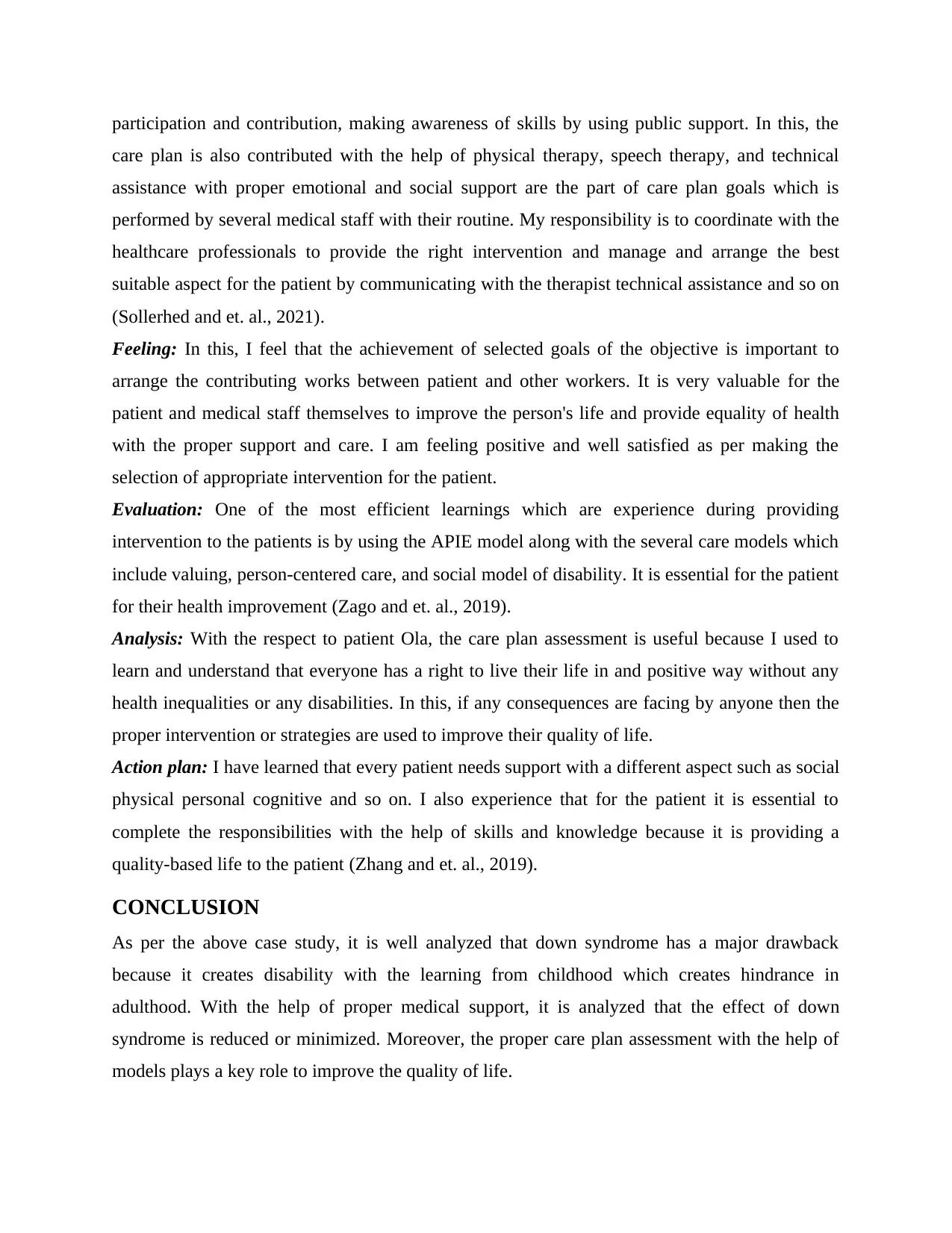
participation and contribution, making awareness of skills by using public support. In this, the
care plan is also contributed with the help of physical therapy, speech therapy, and technical
assistance with proper emotional and social support are the part of care plan goals which is
performed by several medical staff with their routine. My responsibility is to coordinate with the
healthcare professionals to provide the right intervention and manage and arrange the best
suitable aspect for the patient by communicating with the therapist technical assistance and so on
(Sollerhed and et. al., 2021).
Feeling: In this, I feel that the achievement of selected goals of the objective is important to
arrange the contributing works between patient and other workers. It is very valuable for the
patient and medical staff themselves to improve the person's life and provide equality of health
with the proper support and care. I am feeling positive and well satisfied as per making the
selection of appropriate intervention for the patient.
Evaluation: One of the most efficient learnings which are experience during providing
intervention to the patients is by using the APIE model along with the several care models which
include valuing, person-centered care, and social model of disability. It is essential for the patient
for their health improvement (Zago and et. al., 2019).
Analysis: With the respect to patient Ola, the care plan assessment is useful because I used to
learn and understand that everyone has a right to live their life in and positive way without any
health inequalities or any disabilities. In this, if any consequences are facing by anyone then the
proper intervention or strategies are used to improve their quality of life.
Action plan: I have learned that every patient needs support with a different aspect such as social
physical personal cognitive and so on. I also experience that for the patient it is essential to
complete the responsibilities with the help of skills and knowledge because it is providing a
quality-based life to the patient (Zhang and et. al., 2019).
CONCLUSION
As per the above case study, it is well analyzed that down syndrome has a major drawback
because it creates disability with the learning from childhood which creates hindrance in
adulthood. With the help of proper medical support, it is analyzed that the effect of down
syndrome is reduced or minimized. Moreover, the proper care plan assessment with the help of
models plays a key role to improve the quality of life.
care plan is also contributed with the help of physical therapy, speech therapy, and technical
assistance with proper emotional and social support are the part of care plan goals which is
performed by several medical staff with their routine. My responsibility is to coordinate with the
healthcare professionals to provide the right intervention and manage and arrange the best
suitable aspect for the patient by communicating with the therapist technical assistance and so on
(Sollerhed and et. al., 2021).
Feeling: In this, I feel that the achievement of selected goals of the objective is important to
arrange the contributing works between patient and other workers. It is very valuable for the
patient and medical staff themselves to improve the person's life and provide equality of health
with the proper support and care. I am feeling positive and well satisfied as per making the
selection of appropriate intervention for the patient.
Evaluation: One of the most efficient learnings which are experience during providing
intervention to the patients is by using the APIE model along with the several care models which
include valuing, person-centered care, and social model of disability. It is essential for the patient
for their health improvement (Zago and et. al., 2019).
Analysis: With the respect to patient Ola, the care plan assessment is useful because I used to
learn and understand that everyone has a right to live their life in and positive way without any
health inequalities or any disabilities. In this, if any consequences are facing by anyone then the
proper intervention or strategies are used to improve their quality of life.
Action plan: I have learned that every patient needs support with a different aspect such as social
physical personal cognitive and so on. I also experience that for the patient it is essential to
complete the responsibilities with the help of skills and knowledge because it is providing a
quality-based life to the patient (Zhang and et. al., 2019).
CONCLUSION
As per the above case study, it is well analyzed that down syndrome has a major drawback
because it creates disability with the learning from childhood which creates hindrance in
adulthood. With the help of proper medical support, it is analyzed that the effect of down
syndrome is reduced or minimized. Moreover, the proper care plan assessment with the help of
models plays a key role to improve the quality of life.
⊘ This is a preview!⊘
Do you want full access?
Subscribe today to unlock all pages.

Trusted by 1+ million students worldwide
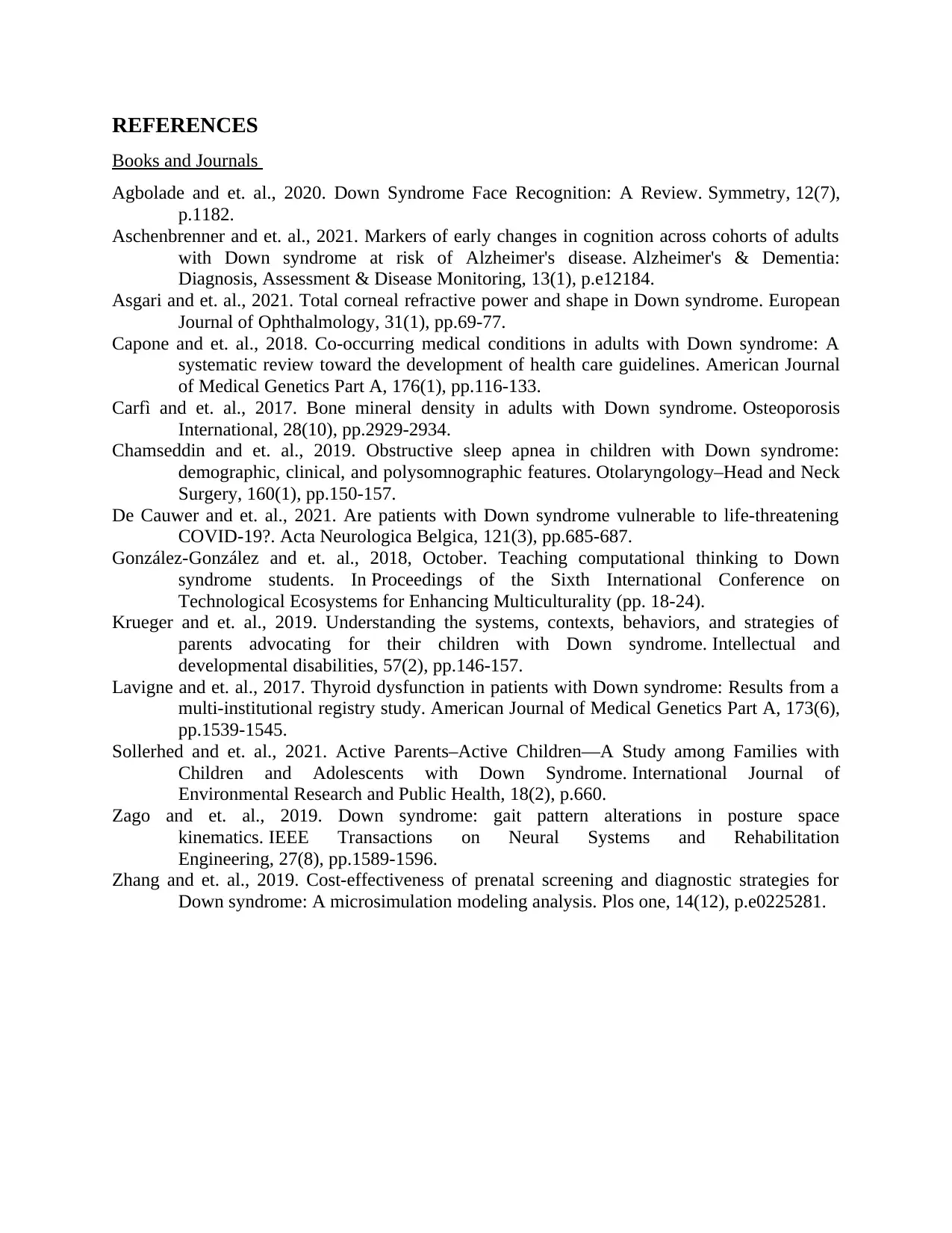
REFERENCES
Books and Journals
Agbolade and et. al., 2020. Down Syndrome Face Recognition: A Review. Symmetry, 12(7),
p.1182.
Aschenbrenner and et. al., 2021. Markers of early changes in cognition across cohorts of adults
with Down syndrome at risk of Alzheimer's disease. Alzheimer's & Dementia:
Diagnosis, Assessment & Disease Monitoring, 13(1), p.e12184.
Asgari and et. al., 2021. Total corneal refractive power and shape in Down syndrome. European
Journal of Ophthalmology, 31(1), pp.69-77.
Capone and et. al., 2018. Co‐occurring medical conditions in adults with Down syndrome: A
systematic review toward the development of health care guidelines. American Journal
of Medical Genetics Part A, 176(1), pp.116-133.
Carfì and et. al., 2017. Bone mineral density in adults with Down syndrome. Osteoporosis
International, 28(10), pp.2929-2934.
Chamseddin and et. al., 2019. Obstructive sleep apnea in children with Down syndrome:
demographic, clinical, and polysomnographic features. Otolaryngology–Head and Neck
Surgery, 160(1), pp.150-157.
De Cauwer and et. al., 2021. Are patients with Down syndrome vulnerable to life-threatening
COVID-19?. Acta Neurologica Belgica, 121(3), pp.685-687.
González-González and et. al., 2018, October. Teaching computational thinking to Down
syndrome students. In Proceedings of the Sixth International Conference on
Technological Ecosystems for Enhancing Multiculturality (pp. 18-24).
Krueger and et. al., 2019. Understanding the systems, contexts, behaviors, and strategies of
parents advocating for their children with Down syndrome. Intellectual and
developmental disabilities, 57(2), pp.146-157.
Lavigne and et. al., 2017. Thyroid dysfunction in patients with Down syndrome: Results from a
multi‐institutional registry study. American Journal of Medical Genetics Part A, 173(6),
pp.1539-1545.
Sollerhed and et. al., 2021. Active Parents–Active Children—A Study among Families with
Children and Adolescents with Down Syndrome. International Journal of
Environmental Research and Public Health, 18(2), p.660.
Zago and et. al., 2019. Down syndrome: gait pattern alterations in posture space
kinematics. IEEE Transactions on Neural Systems and Rehabilitation
Engineering, 27(8), pp.1589-1596.
Zhang and et. al., 2019. Cost-effectiveness of prenatal screening and diagnostic strategies for
Down syndrome: A microsimulation modeling analysis. Plos one, 14(12), p.e0225281.
Books and Journals
Agbolade and et. al., 2020. Down Syndrome Face Recognition: A Review. Symmetry, 12(7),
p.1182.
Aschenbrenner and et. al., 2021. Markers of early changes in cognition across cohorts of adults
with Down syndrome at risk of Alzheimer's disease. Alzheimer's & Dementia:
Diagnosis, Assessment & Disease Monitoring, 13(1), p.e12184.
Asgari and et. al., 2021. Total corneal refractive power and shape in Down syndrome. European
Journal of Ophthalmology, 31(1), pp.69-77.
Capone and et. al., 2018. Co‐occurring medical conditions in adults with Down syndrome: A
systematic review toward the development of health care guidelines. American Journal
of Medical Genetics Part A, 176(1), pp.116-133.
Carfì and et. al., 2017. Bone mineral density in adults with Down syndrome. Osteoporosis
International, 28(10), pp.2929-2934.
Chamseddin and et. al., 2019. Obstructive sleep apnea in children with Down syndrome:
demographic, clinical, and polysomnographic features. Otolaryngology–Head and Neck
Surgery, 160(1), pp.150-157.
De Cauwer and et. al., 2021. Are patients with Down syndrome vulnerable to life-threatening
COVID-19?. Acta Neurologica Belgica, 121(3), pp.685-687.
González-González and et. al., 2018, October. Teaching computational thinking to Down
syndrome students. In Proceedings of the Sixth International Conference on
Technological Ecosystems for Enhancing Multiculturality (pp. 18-24).
Krueger and et. al., 2019. Understanding the systems, contexts, behaviors, and strategies of
parents advocating for their children with Down syndrome. Intellectual and
developmental disabilities, 57(2), pp.146-157.
Lavigne and et. al., 2017. Thyroid dysfunction in patients with Down syndrome: Results from a
multi‐institutional registry study. American Journal of Medical Genetics Part A, 173(6),
pp.1539-1545.
Sollerhed and et. al., 2021. Active Parents–Active Children—A Study among Families with
Children and Adolescents with Down Syndrome. International Journal of
Environmental Research and Public Health, 18(2), p.660.
Zago and et. al., 2019. Down syndrome: gait pattern alterations in posture space
kinematics. IEEE Transactions on Neural Systems and Rehabilitation
Engineering, 27(8), pp.1589-1596.
Zhang and et. al., 2019. Cost-effectiveness of prenatal screening and diagnostic strategies for
Down syndrome: A microsimulation modeling analysis. Plos one, 14(12), p.e0225281.
1 out of 10
Related Documents
Your All-in-One AI-Powered Toolkit for Academic Success.
+13062052269
info@desklib.com
Available 24*7 on WhatsApp / Email
![[object Object]](/_next/static/media/star-bottom.7253800d.svg)
Unlock your academic potential
Copyright © 2020–2025 A2Z Services. All Rights Reserved. Developed and managed by ZUCOL.



